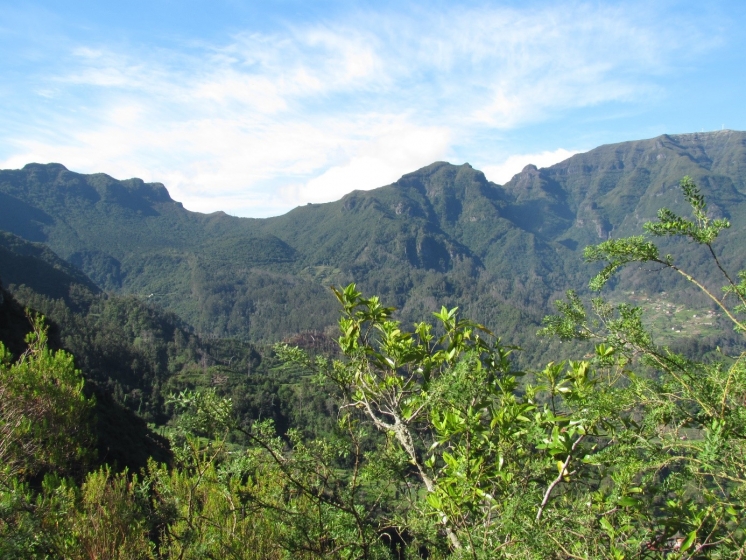Portuguese Parks to the world/Parques Portugueses no Mundo
- Written by sara pinto
- Published in News
This month – The Madeira Natural Park by Sandra Kiesow (Kiel University)
https://www.ecosystems.uni-kiel.de/en/e_personen_oeko_polar/personal-homepage/skiesow
The Madeira Natural Park is situated on the island of Madeira, covering approximately two-thirds of the islands´ surface area. It was founded in 1982 with the aim to safeguard the outstandingly high biodiversity of its ecosystems, very rich in endemic flora and fauna. The mountainous landscape structure with deep ravines and steep mountainsides offers a large number of divers habitats, reaching from coastal zones with subtropical climate to high mountain areas with more aggressive climatic conditions.
The most famous ecosystem on Madeira is the evergreen laurisilva forest, mainly consisting of huge trees of the family of “Lauraceas” like Til, Bay tree, Barbusan tree and Madeira Mahogany. With an extension of approximately 15.000 ha it is the largest laurisilva forest in the world and home to a large number of endangered species. In 1999, it has been recognized as World Natural Heritage by UNESCO (https://whc.unesco.org/en/list/934/video).
At higher altitude, a unique heather forest with many endemic species covers the mountains and contributes with its capacity to filter water out of the clouds to ground water recharge on the island. All over the island one can find the Levadas, small irrigation channels transporting water towards the agricultural terraces. Close to their springs in the Madeira Natural Park, they offer a very pleasant way to discover the natural beauty of the island on foot (https://www.youtube.com/watch?v=Q4l0f1kycC8).
More information at:
https://ifcn.madeira.gov.pt/areas-protegidas/parque-natural-da-madeira.html
Kiesow, S. & Bork, H.-R., 2017. Agricultural terraces as a proxy to landscape history on Madeira island, Portugal. Ler História, Nr. 71, pp. 127-152
Kiesow, S. & Dierssen, K., 2017. Vegetation Analysis as a Source of Historic Information – The Case of Madeira Island. In Vaz, E., Melo, C. J. D., & Costa Pinto, L. M. (2017). Environmental History in the Making: Volume I: Explaining. (Environmental History; No. 6). Switzerland: Springer International Publishing, pp. 123-144.
-----------------------------------------------------------------------------------------------------------
Este mês - O Parque Natural da Madeira por Sandra Kiesow (Kiel University)
https://www.ecosystems.uni-kiel.de/en/e_personen_oeko_polar/personal-homepage/skiesow
O Parque Natural da Madeira está localizado no arquipélago da Madeira e abrange cerca de dois-terços da superficie insular. O parque foi fundado em 1982 com o objectivo de salvaguardar a extraordinária biodiversidade dos seus ecossistemas ricos em endemismos, a nível de flora e fauna. A paisagem montanhosa, com ribeiras fundas e picos altos, ofereçe um grande número de habitats diversos, incluindo as zonas costeiras, com o seu clima subtropical, até os picos mais altos, com condições climatéricas mais agrestes.
O ecosistema mais famoso da ilha da Madeira é a floresta Laurisilva, caracterizada pelas suas árvores de grande porte, da família das Lauráceas, como o Til, o Loureiro, o Barbusano e o Vinhático. Com uma área de, aproximadamente, 15.000 hectares, esta é a maior floresta laurisilva a nível mundial e muito rica em endemismos. Em 1999, a Laurisilva da Madeira foi classificada como Património da Humanidade pela UNESCO (https://whc.unesco.org/en/list/934/video).
As zonas mais altas da ilha estão cobertas pelo Urzal de altitude, também muito rico em endemismos. O Urzal tem um papel importante na recarga dos recursos de água subterrânea, as urzes filtram gotículas minúsculas de água diretamente dos nevoeiros.
Em toda a ilha encontram-se as Levadas, transportando água das serras aos campos. Perto das suas nascentes, no Parque Natural da Madeira, elas convidam o visitante à descoberta, a pé, das belezas naturais da ilha (https://www.youtube.com/watch?v=Q4l0f1kycC8).
Mais informação em:
https://ifcn.madeira.gov.pt/areas-protegidas/parque-natural-da-madeira.html
Kiesow, S. & Bork, H.-R., 2017. Agricultural terraces as a proxy to landscape history on Madeira island, Portugal. Ler História, Nr. 71, pp. 127-152
Kiesow, S. & Dierssen, K., 2017. Vegetation Analysis as a Source of Historic Information – The Case of Madeira Island. In Vaz, E., Melo, C. J. D., & Costa Pinto, L. M. (2017). Environmental History in the Making: Volume I: Explaining. (Environmental History; No. 6). Switzerland: Springer International Publishing, pp. 123-144.

